Student's Investment Policy Statement Workbook for M & S Ford
VerifiedAdded on 2023/02/01
|16
|3980
|67
Project
AI Summary
This investment policy statement workbook, prepared by a student, meticulously analyzes the financial situation of Michel and Susan Ford. It begins with a comprehensive overview of their current financial standing, detailing personal information, assets, liabilities, and current cash flow. The workbook then outlines their financial objectives, including primary and secondary goals, and performs a five-year cash flow analysis. It establishes return and risk objectives, incorporating a risk profile questionnaire to assess their tolerance for investment volatility. Constraints are identified, and a proposed asset allocation strategy is presented. Finally, the document covers portfolio monitoring, review processes, and an action plan to ensure the Fords stay on track with their financial goals. The analysis encompasses various aspects of financial planning, including retirement planning, and guides the development of a suitable investment strategy. The document concludes with an authority to proceed, indicating the steps required for the implementation of the plan.
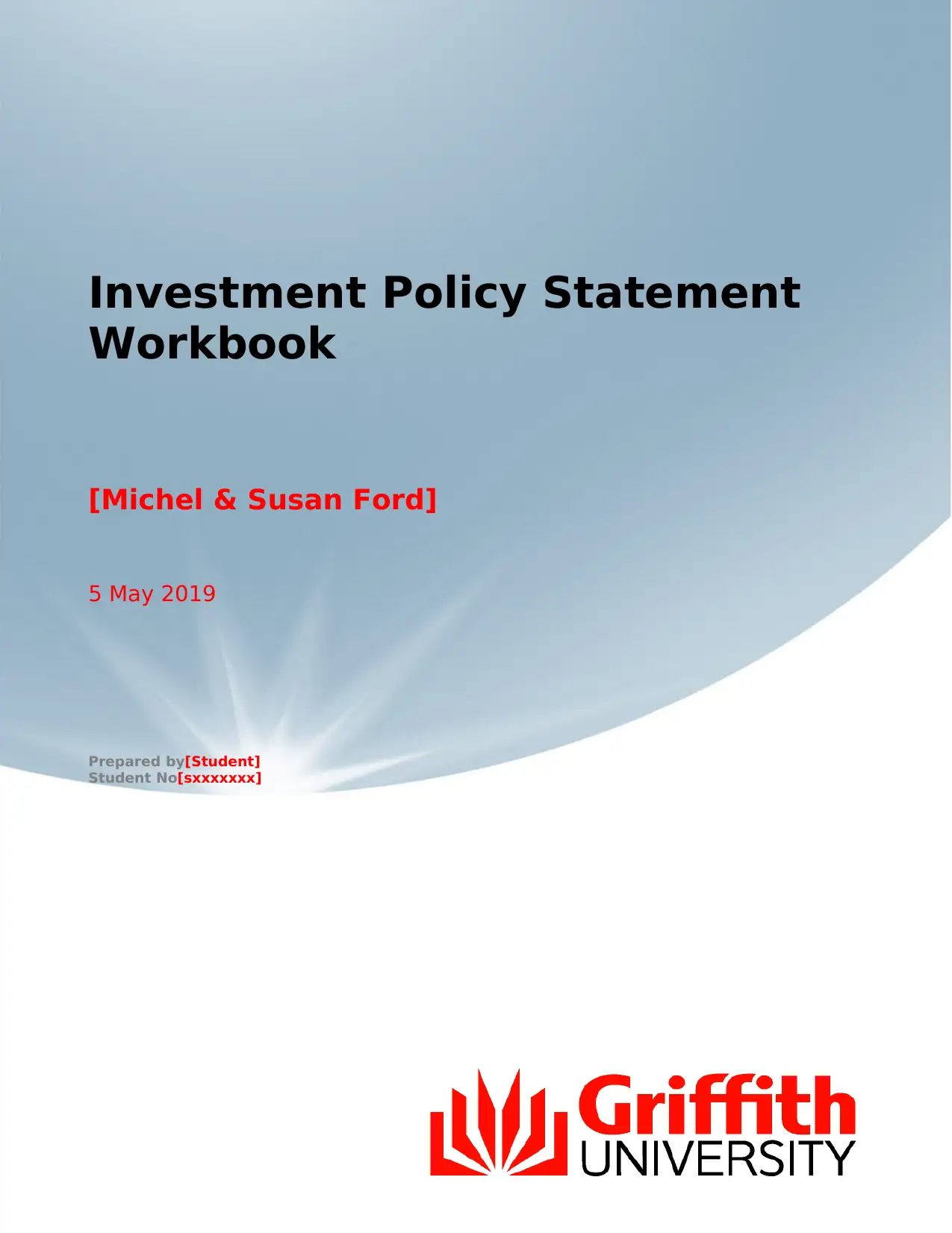
Investment Policy Statement
Workbook
[Michel & Susan Ford]
5 May 2019
Prepared by[Student]
Student No[sxxxxxxx]
Workbook
[Michel & Susan Ford]
5 May 2019
Prepared by[Student]
Student No[sxxxxxxx]
Paraphrase This Document
Need a fresh take? Get an instant paraphrase of this document with our AI Paraphraser
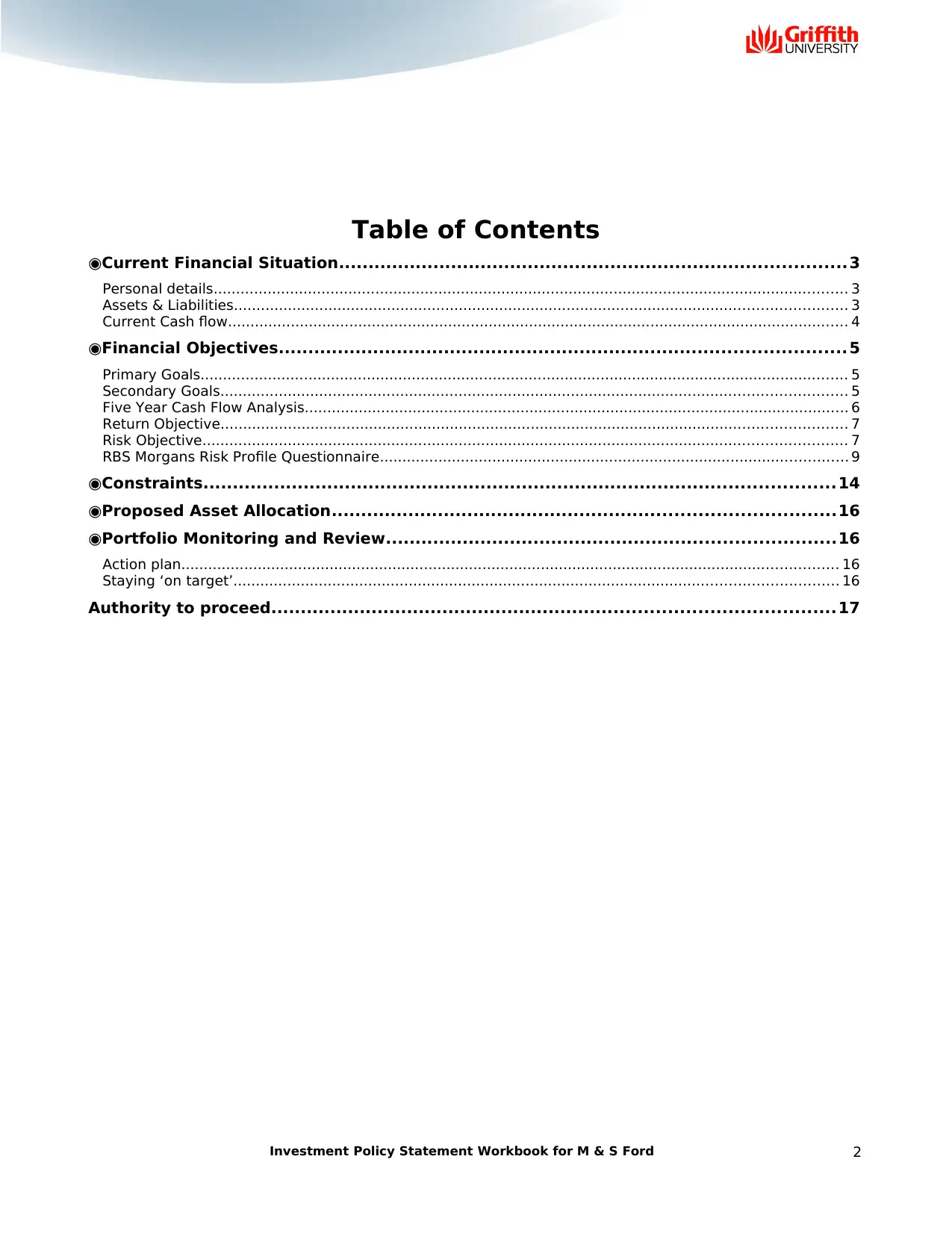
Table of Contents
◉Current Financial Situation......................................................................................3
Personal details............................................................................................................................................. 3
Assets & Liabilities........................................................................................................................................ 3
Current Cash flow.......................................................................................................................................... 4
◉Financial Objectives................................................................................................ 5
Primary Goals................................................................................................................................................ 5
Secondary Goals........................................................................................................................................... 5
Five Year Cash Flow Analysis......................................................................................................................... 6
Return Objective........................................................................................................................................... 7
Risk Objective............................................................................................................................................... 7
RBS Morgans Risk Profile Questionnaire........................................................................................................ 9
◉Constraints........................................................................................................... 14
◉Proposed Asset Allocation.....................................................................................16
◉Portfolio Monitoring and Review............................................................................16
Action plan.................................................................................................................................................. 16
Staying ‘on target’...................................................................................................................................... 16
Authority to proceed............................................................................................... 17
Investment Policy Statement Workbook for M & S Ford 2
◉Current Financial Situation......................................................................................3
Personal details............................................................................................................................................. 3
Assets & Liabilities........................................................................................................................................ 3
Current Cash flow.......................................................................................................................................... 4
◉Financial Objectives................................................................................................ 5
Primary Goals................................................................................................................................................ 5
Secondary Goals........................................................................................................................................... 5
Five Year Cash Flow Analysis......................................................................................................................... 6
Return Objective........................................................................................................................................... 7
Risk Objective............................................................................................................................................... 7
RBS Morgans Risk Profile Questionnaire........................................................................................................ 9
◉Constraints........................................................................................................... 14
◉Proposed Asset Allocation.....................................................................................16
◉Portfolio Monitoring and Review............................................................................16
Action plan.................................................................................................................................................. 16
Staying ‘on target’...................................................................................................................................... 16
Authority to proceed............................................................................................... 17
Investment Policy Statement Workbook for M & S Ford 2
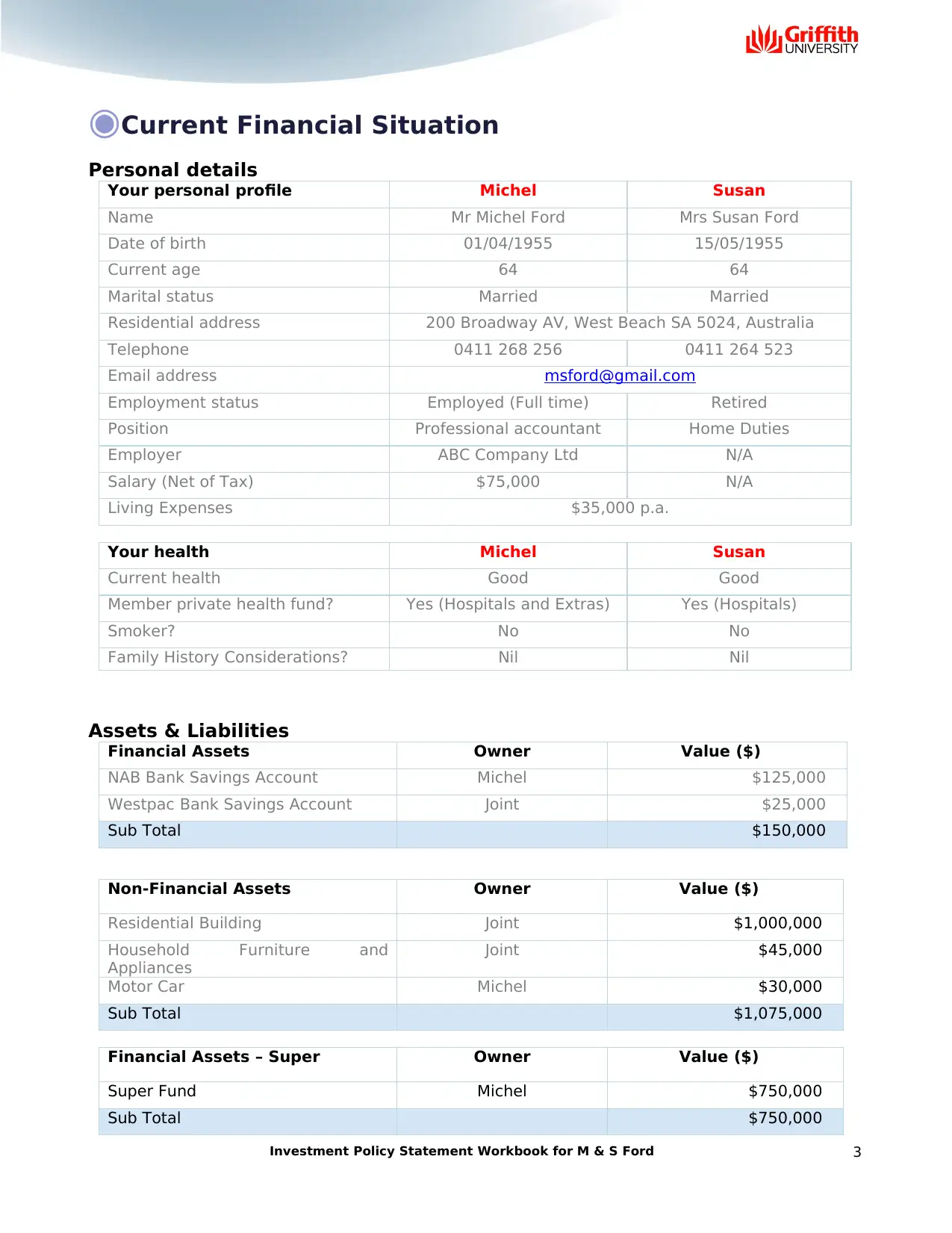
◉Current Financial Situation
Personal details
Your personal profile Michel Susan
Name Mr Michel Ford Mrs Susan Ford
Date of birth 01/04/1955 15/05/1955
Current age 64 64
Marital status Married Married
Residential address 200 Broadway AV, West Beach SA 5024, Australia
Telephone 0411 268 256 0411 264 523
Email address msford@gmail.com
Employment status Employed (Full time) Retired
Position Professional accountant Home Duties
Employer ABC Company Ltd N/A
Salary (Net of Tax) $75,000 N/A
Living Expenses $35,000 p.a.
Your health Michel Susan
Current health Good Good
Member private health fund? Yes (Hospitals and Extras) Yes (Hospitals)
Smoker? No No
Family History Considerations? Nil Nil
Assets & Liabilities
Financial Assets Owner Value ($)
NAB Bank Savings Account Michel $125,000
Westpac Bank Savings Account Joint $25,000
Sub Total $150,000
Non-Financial Assets Owner Value ($)
Residential Building Joint $1,000,000
Household Furniture and
Appliances
Joint $45,000
Motor Car Michel $30,000
Sub Total $1,075,000
Financial Assets – Super Owner Value ($)
Super Fund Michel $750,000
Sub Total $750,000
Investment Policy Statement Workbook for M & S Ford 3
Personal details
Your personal profile Michel Susan
Name Mr Michel Ford Mrs Susan Ford
Date of birth 01/04/1955 15/05/1955
Current age 64 64
Marital status Married Married
Residential address 200 Broadway AV, West Beach SA 5024, Australia
Telephone 0411 268 256 0411 264 523
Email address msford@gmail.com
Employment status Employed (Full time) Retired
Position Professional accountant Home Duties
Employer ABC Company Ltd N/A
Salary (Net of Tax) $75,000 N/A
Living Expenses $35,000 p.a.
Your health Michel Susan
Current health Good Good
Member private health fund? Yes (Hospitals and Extras) Yes (Hospitals)
Smoker? No No
Family History Considerations? Nil Nil
Assets & Liabilities
Financial Assets Owner Value ($)
NAB Bank Savings Account Michel $125,000
Westpac Bank Savings Account Joint $25,000
Sub Total $150,000
Non-Financial Assets Owner Value ($)
Residential Building Joint $1,000,000
Household Furniture and
Appliances
Joint $45,000
Motor Car Michel $30,000
Sub Total $1,075,000
Financial Assets – Super Owner Value ($)
Super Fund Michel $750,000
Sub Total $750,000
Investment Policy Statement Workbook for M & S Ford 3
⊘ This is a preview!⊘
Do you want full access?
Subscribe today to unlock all pages.

Trusted by 1+ million students worldwide
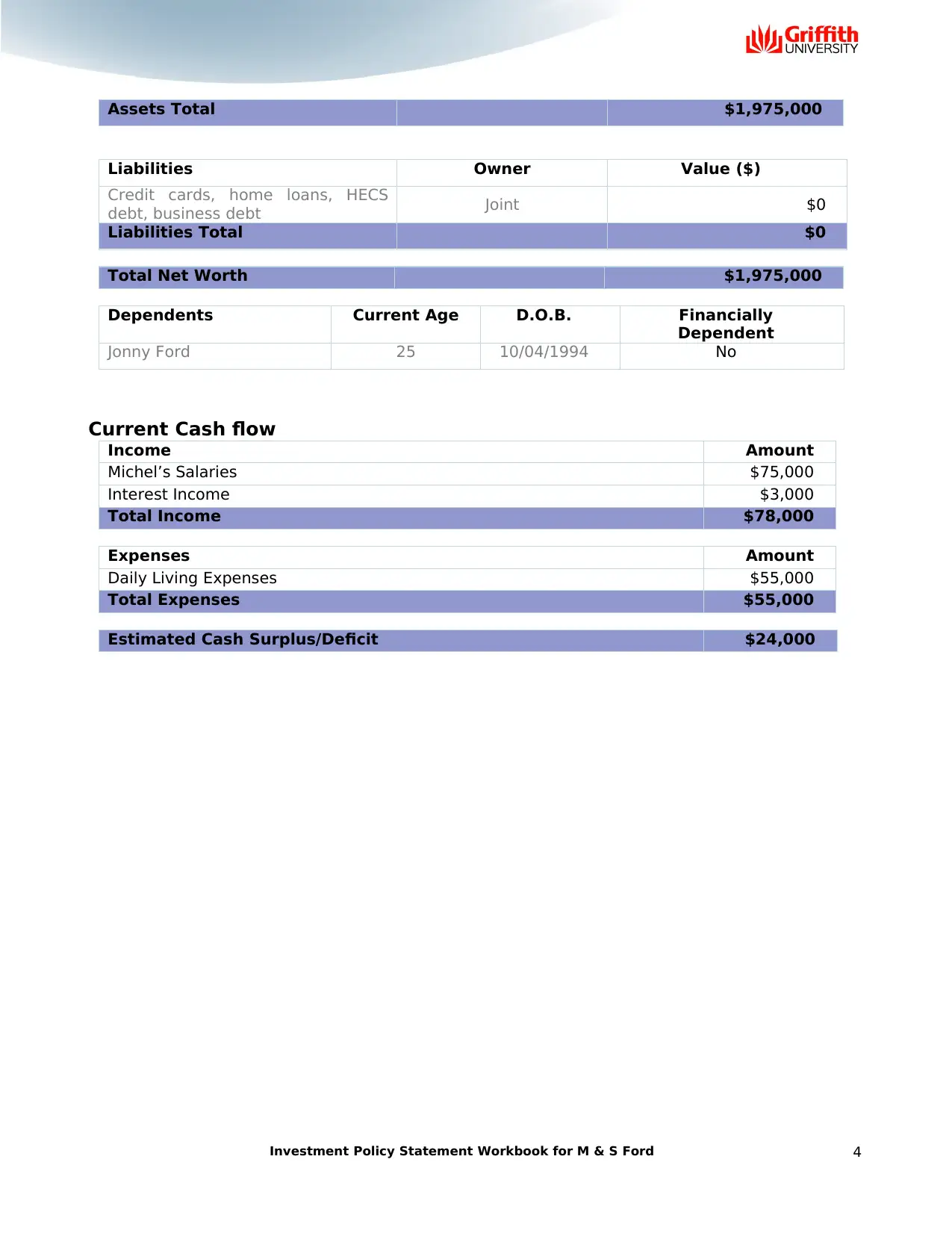
Assets Total $1,975,000
Liabilities Owner Value ($)
Credit cards, home loans, HECS
debt, business debt Joint $0
Liabilities Total $0
Total Net Worth $1,975,000
Dependents Current Age D.O.B. Financially
Dependent
Jonny Ford 25 10/04/1994 No
Current Cash flow
Income Amount
Michel’s Salaries $75,000
Interest Income $3,000
Total Income $78,000
Expenses Amount
Daily Living Expenses $55,000
Total Expenses $55,000
Estimated Cash Surplus/Deficit $24,000
Investment Policy Statement Workbook for M & S Ford 4
Liabilities Owner Value ($)
Credit cards, home loans, HECS
debt, business debt Joint $0
Liabilities Total $0
Total Net Worth $1,975,000
Dependents Current Age D.O.B. Financially
Dependent
Jonny Ford 25 10/04/1994 No
Current Cash flow
Income Amount
Michel’s Salaries $75,000
Interest Income $3,000
Total Income $78,000
Expenses Amount
Daily Living Expenses $55,000
Total Expenses $55,000
Estimated Cash Surplus/Deficit $24,000
Investment Policy Statement Workbook for M & S Ford 4
Paraphrase This Document
Need a fresh take? Get an instant paraphrase of this document with our AI Paraphraser
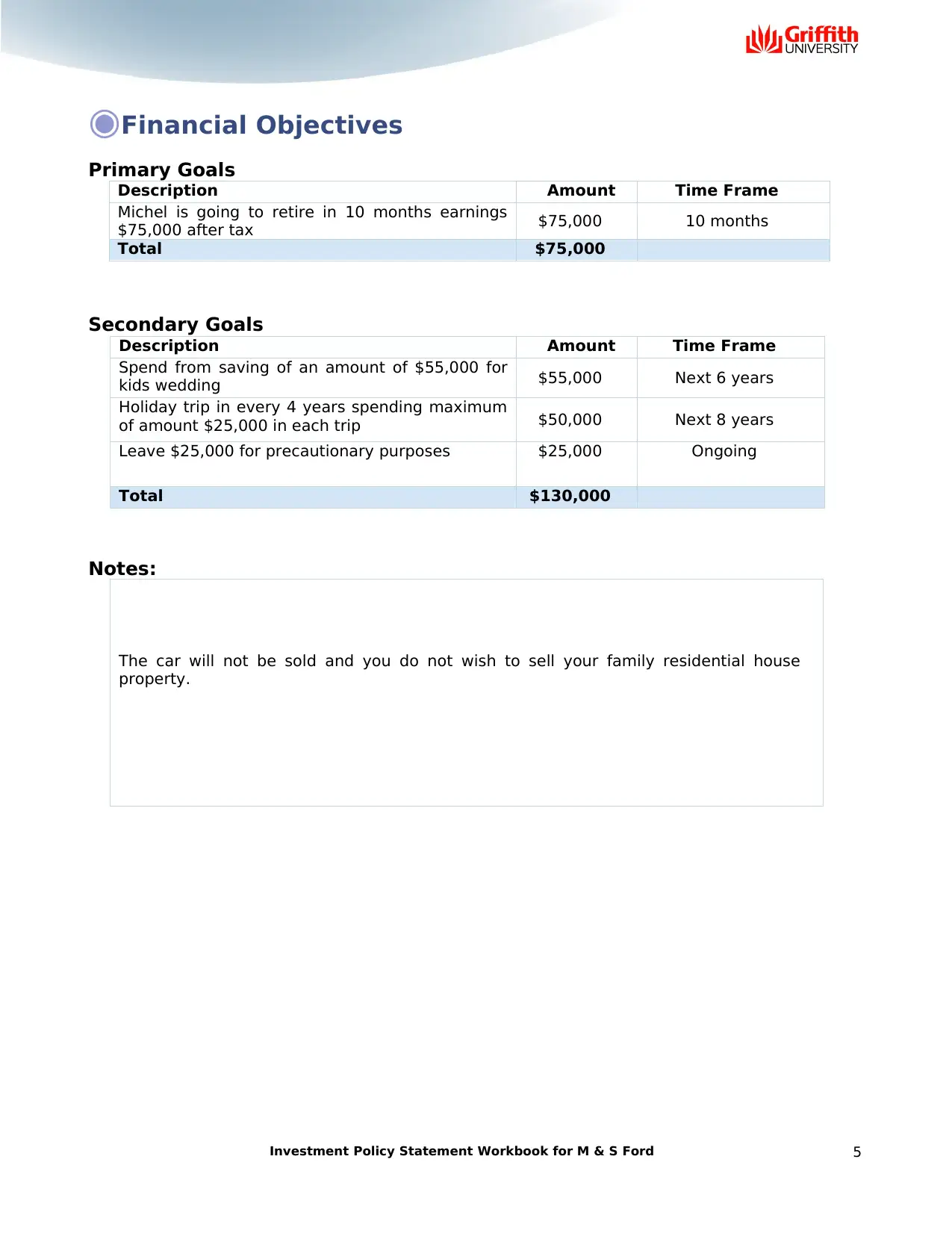
◉Financial Objectives
Primary Goals
Description Amount Time Frame
Michel is going to retire in 10 months earnings
$75,000 after tax $75,000 10 months
Total $75,000
Secondary Goals
Description Amount Time Frame
Spend from saving of an amount of $55,000 for
kids wedding $55,000 Next 6 years
Holiday trip in every 4 years spending maximum
of amount $25,000 in each trip $50,000 Next 8 years
Leave $25,000 for precautionary purposes $25,000 Ongoing
Total $130,000
Notes:
The car will not be sold and you do not wish to sell your family residential house
property.
Investment Policy Statement Workbook for M & S Ford 5
Primary Goals
Description Amount Time Frame
Michel is going to retire in 10 months earnings
$75,000 after tax $75,000 10 months
Total $75,000
Secondary Goals
Description Amount Time Frame
Spend from saving of an amount of $55,000 for
kids wedding $55,000 Next 6 years
Holiday trip in every 4 years spending maximum
of amount $25,000 in each trip $50,000 Next 8 years
Leave $25,000 for precautionary purposes $25,000 Ongoing
Total $130,000
Notes:
The car will not be sold and you do not wish to sell your family residential house
property.
Investment Policy Statement Workbook for M & S Ford 5
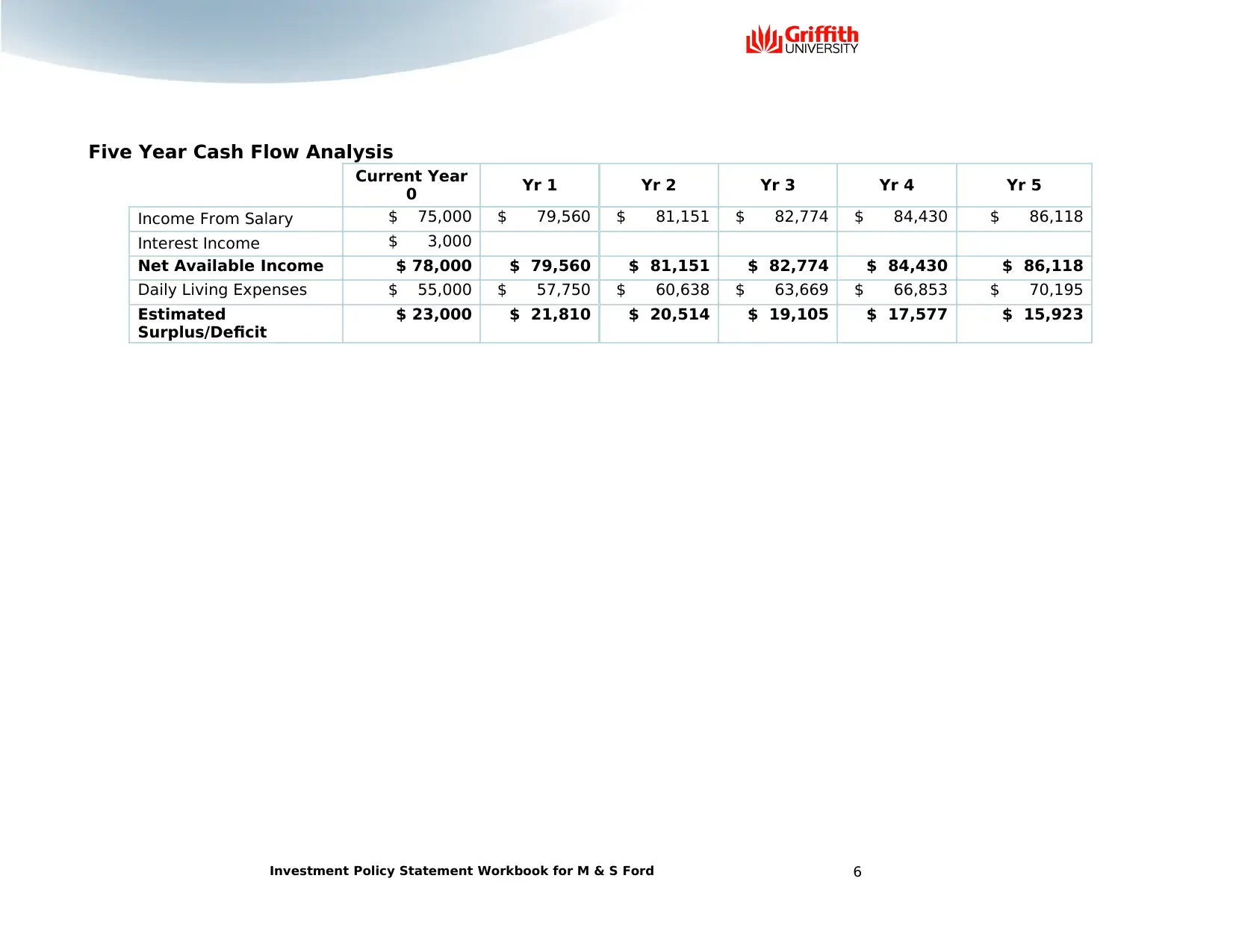
Five Year Cash Flow Analysis
Current Year
0 Yr 1 Yr 2 Yr 3 Yr 4 Yr 5
Income From Salary $ 75,000 $ 79,560 $ 81,151 $ 82,774 $ 84,430 $ 86,118
Interest Income $ 3,000
Net Available Income $ 78,000 $ 79,560 $ 81,151 $ 82,774 $ 84,430 $ 86,118
Daily Living Expenses $ 55,000 $ 57,750 $ 60,638 $ 63,669 $ 66,853 $ 70,195
Estimated
Surplus/Deficit
$ 23,000 $ 21,810 $ 20,514 $ 19,105 $ 17,577 $ 15,923
Investment Policy Statement Workbook for M & S Ford 6
Current Year
0 Yr 1 Yr 2 Yr 3 Yr 4 Yr 5
Income From Salary $ 75,000 $ 79,560 $ 81,151 $ 82,774 $ 84,430 $ 86,118
Interest Income $ 3,000
Net Available Income $ 78,000 $ 79,560 $ 81,151 $ 82,774 $ 84,430 $ 86,118
Daily Living Expenses $ 55,000 $ 57,750 $ 60,638 $ 63,669 $ 66,853 $ 70,195
Estimated
Surplus/Deficit
$ 23,000 $ 21,810 $ 20,514 $ 19,105 $ 17,577 $ 15,923
Investment Policy Statement Workbook for M & S Ford 6
⊘ This is a preview!⊘
Do you want full access?
Subscribe today to unlock all pages.

Trusted by 1+ million students worldwide
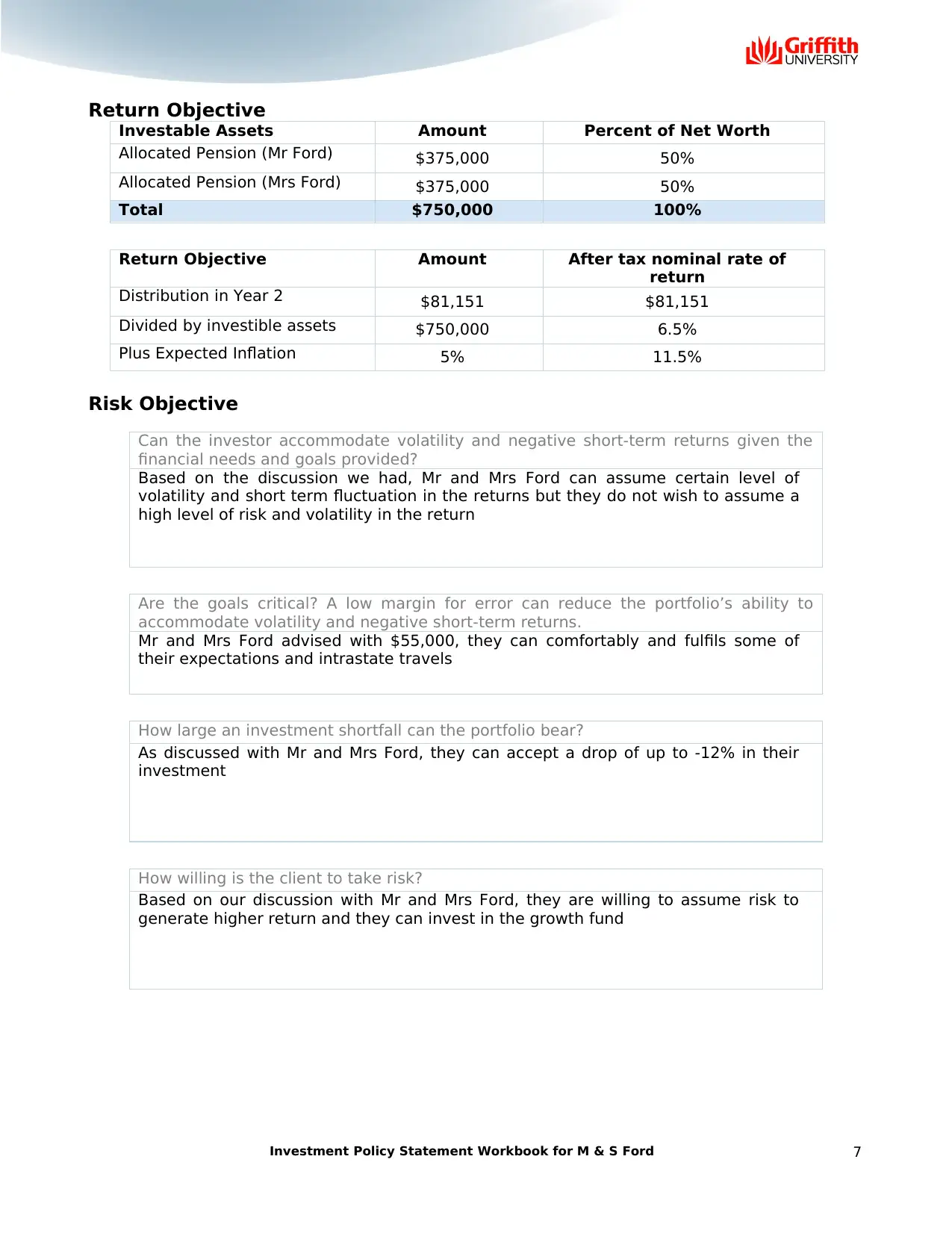
Return Objective
Investable Assets Amount Percent of Net Worth
Allocated Pension (Mr Ford) $375,000 50%
Allocated Pension (Mrs Ford) $375,000 50%
Total $750,000 100%
Return Objective Amount After tax nominal rate of
return
Distribution in Year 2 $81,151 $81,151
Divided by investible assets $750,000 6.5%
Plus Expected Inflation 5% 11.5%
Risk Objective
Can the investor accommodate volatility and negative short-term returns given the
financial needs and goals provided?
Based on the discussion we had, Mr and Mrs Ford can assume certain level of
volatility and short term fluctuation in the returns but they do not wish to assume a
high level of risk and volatility in the return
Are the goals critical? A low margin for error can reduce the portfolio’s ability to
accommodate volatility and negative short-term returns.
Mr and Mrs Ford advised with $55,000, they can comfortably and fulfils some of
their expectations and intrastate travels
How large an investment shortfall can the portfolio bear?
As discussed with Mr and Mrs Ford, they can accept a drop of up to -12% in their
investment
How willing is the client to take risk?
Based on our discussion with Mr and Mrs Ford, they are willing to assume risk to
generate higher return and they can invest in the growth fund
Investment Policy Statement Workbook for M & S Ford 7
Investable Assets Amount Percent of Net Worth
Allocated Pension (Mr Ford) $375,000 50%
Allocated Pension (Mrs Ford) $375,000 50%
Total $750,000 100%
Return Objective Amount After tax nominal rate of
return
Distribution in Year 2 $81,151 $81,151
Divided by investible assets $750,000 6.5%
Plus Expected Inflation 5% 11.5%
Risk Objective
Can the investor accommodate volatility and negative short-term returns given the
financial needs and goals provided?
Based on the discussion we had, Mr and Mrs Ford can assume certain level of
volatility and short term fluctuation in the returns but they do not wish to assume a
high level of risk and volatility in the return
Are the goals critical? A low margin for error can reduce the portfolio’s ability to
accommodate volatility and negative short-term returns.
Mr and Mrs Ford advised with $55,000, they can comfortably and fulfils some of
their expectations and intrastate travels
How large an investment shortfall can the portfolio bear?
As discussed with Mr and Mrs Ford, they can accept a drop of up to -12% in their
investment
How willing is the client to take risk?
Based on our discussion with Mr and Mrs Ford, they are willing to assume risk to
generate higher return and they can invest in the growth fund
Investment Policy Statement Workbook for M & S Ford 7
Paraphrase This Document
Need a fresh take? Get an instant paraphrase of this document with our AI Paraphraser
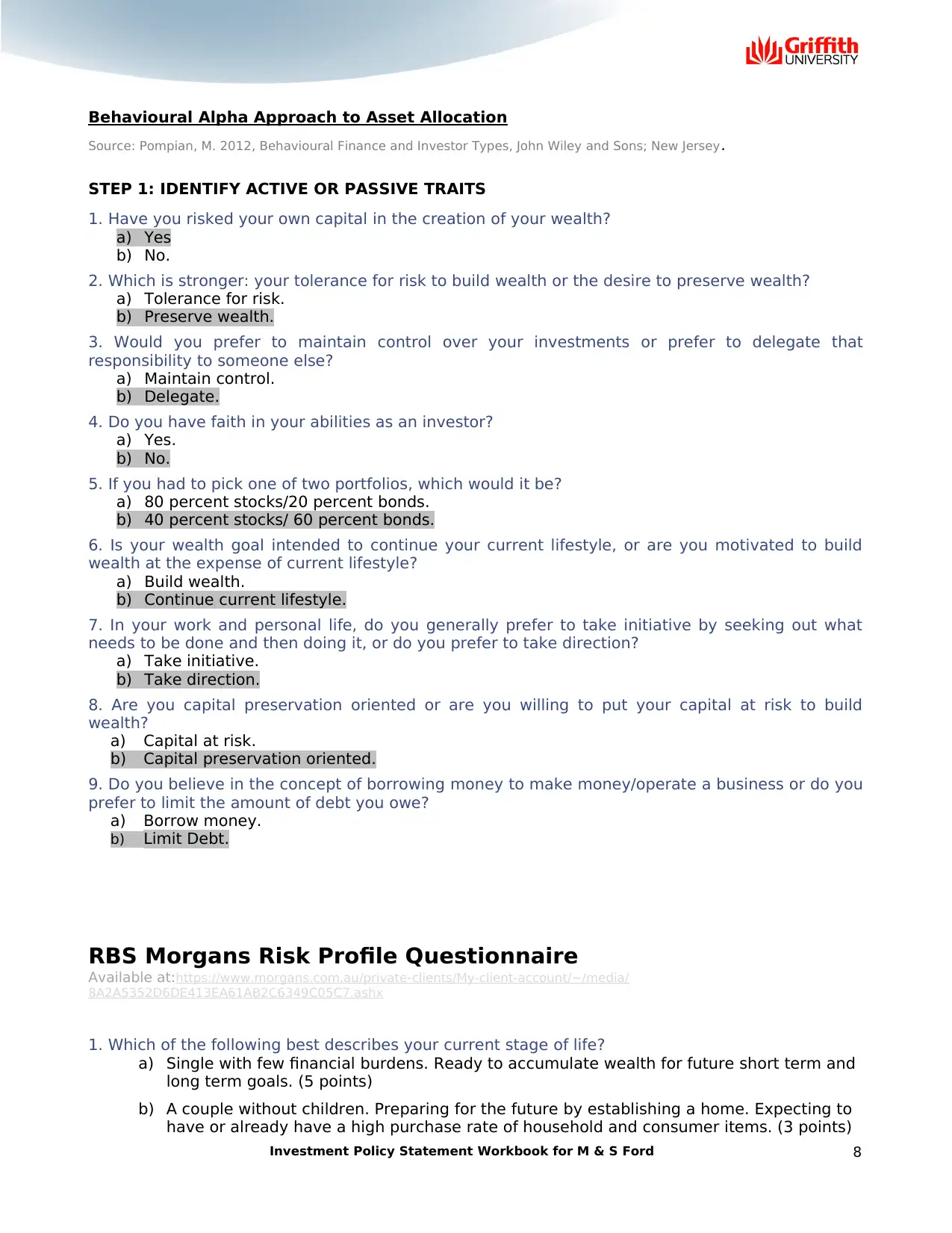
Behavioural Alpha Approach to Asset Allocation
Source: Pompian, M. 2012, Behavioural Finance and Investor Types, John Wiley and Sons; New Jersey.
STEP 1: IDENTIFY ACTIVE OR PASSIVE TRAITS
1. Have you risked your own capital in the creation of your wealth?
a) Yes
b) No.
2. Which is stronger: your tolerance for risk to build wealth or the desire to preserve wealth?
a) Tolerance for risk.
b) Preserve wealth.
3. Would you prefer to maintain control over your investments or prefer to delegate that
responsibility to someone else?
a) Maintain control.
b) Delegate.
4. Do you have faith in your abilities as an investor?
a) Yes.
b) No.
5. If you had to pick one of two portfolios, which would it be?
a) 80 percent stocks/20 percent bonds.
b) 40 percent stocks/ 60 percent bonds.
6. Is your wealth goal intended to continue your current lifestyle, or are you motivated to build
wealth at the expense of current lifestyle?
a) Build wealth.
b) Continue current lifestyle.
7. In your work and personal life, do you generally prefer to take initiative by seeking out what
needs to be done and then doing it, or do you prefer to take direction?
a) Take initiative.
b) Take direction.
8. Are you capital preservation oriented or are you willing to put your capital at risk to build
wealth?
a) Capital at risk.
b) Capital preservation oriented.
9. Do you believe in the concept of borrowing money to make money/operate a business or do you
prefer to limit the amount of debt you owe?
a) Borrow money.
b) Limit Debt.
RBS Morgans Risk Profile Questionnaire
Available at:https://www.morgans.com.au/private-clients/My-client-account/~/media/
8A2A5352D6DE413EA61AB2C6349C05C7.ashx
1. Which of the following best describes your current stage of life?
a) Single with few financial burdens. Ready to accumulate wealth for future short term and
long term goals. (5 points)
b) A couple without children. Preparing for the future by establishing a home. Expecting to
have or already have a high purchase rate of household and consumer items. (3 points)
Investment Policy Statement Workbook for M & S Ford 8
Source: Pompian, M. 2012, Behavioural Finance and Investor Types, John Wiley and Sons; New Jersey.
STEP 1: IDENTIFY ACTIVE OR PASSIVE TRAITS
1. Have you risked your own capital in the creation of your wealth?
a) Yes
b) No.
2. Which is stronger: your tolerance for risk to build wealth or the desire to preserve wealth?
a) Tolerance for risk.
b) Preserve wealth.
3. Would you prefer to maintain control over your investments or prefer to delegate that
responsibility to someone else?
a) Maintain control.
b) Delegate.
4. Do you have faith in your abilities as an investor?
a) Yes.
b) No.
5. If you had to pick one of two portfolios, which would it be?
a) 80 percent stocks/20 percent bonds.
b) 40 percent stocks/ 60 percent bonds.
6. Is your wealth goal intended to continue your current lifestyle, or are you motivated to build
wealth at the expense of current lifestyle?
a) Build wealth.
b) Continue current lifestyle.
7. In your work and personal life, do you generally prefer to take initiative by seeking out what
needs to be done and then doing it, or do you prefer to take direction?
a) Take initiative.
b) Take direction.
8. Are you capital preservation oriented or are you willing to put your capital at risk to build
wealth?
a) Capital at risk.
b) Capital preservation oriented.
9. Do you believe in the concept of borrowing money to make money/operate a business or do you
prefer to limit the amount of debt you owe?
a) Borrow money.
b) Limit Debt.
RBS Morgans Risk Profile Questionnaire
Available at:https://www.morgans.com.au/private-clients/My-client-account/~/media/
8A2A5352D6DE413EA61AB2C6349C05C7.ashx
1. Which of the following best describes your current stage of life?
a) Single with few financial burdens. Ready to accumulate wealth for future short term and
long term goals. (5 points)
b) A couple without children. Preparing for the future by establishing a home. Expecting to
have or already have a high purchase rate of household and consumer items. (3 points)
Investment Policy Statement Workbook for M & S Ford 8
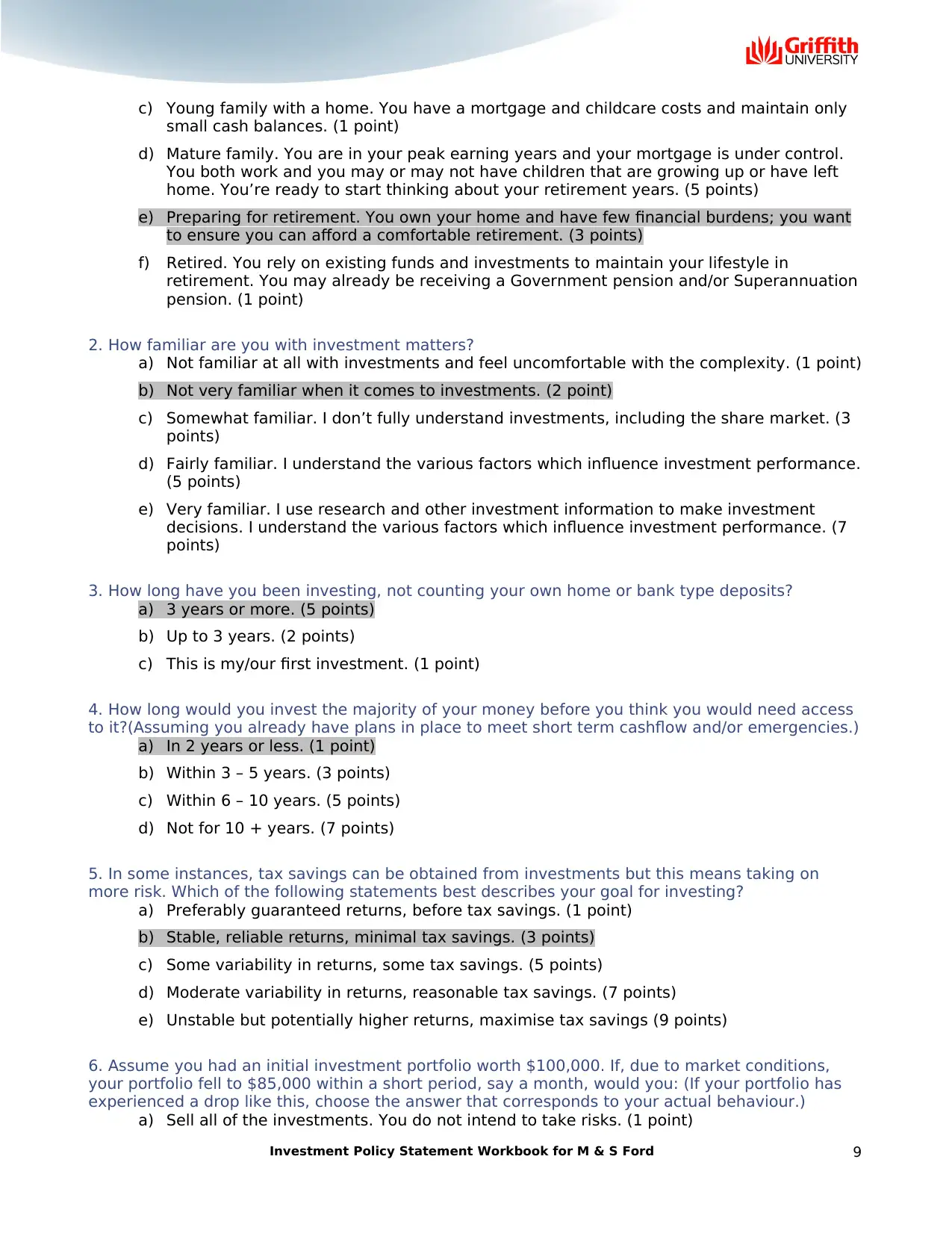
c) Young family with a home. You have a mortgage and childcare costs and maintain only
small cash balances. (1 point)
d) Mature family. You are in your peak earning years and your mortgage is under control.
You both work and you may or may not have children that are growing up or have left
home. You’re ready to start thinking about your retirement years. (5 points)
e) Preparing for retirement. You own your home and have few financial burdens; you want
to ensure you can afford a comfortable retirement. (3 points)
f) Retired. You rely on existing funds and investments to maintain your lifestyle in
retirement. You may already be receiving a Government pension and/or Superannuation
pension. (1 point)
2. How familiar are you with investment matters?
a) Not familiar at all with investments and feel uncomfortable with the complexity. (1 point)
b) Not very familiar when it comes to investments. (2 point)
c) Somewhat familiar. I don’t fully understand investments, including the share market. (3
points)
d) Fairly familiar. I understand the various factors which influence investment performance.
(5 points)
e) Very familiar. I use research and other investment information to make investment
decisions. I understand the various factors which influence investment performance. (7
points)
3. How long have you been investing, not counting your own home or bank type deposits?
a) 3 years or more. (5 points)
b) Up to 3 years. (2 points)
c) This is my/our first investment. (1 point)
4. How long would you invest the majority of your money before you think you would need access
to it?(Assuming you already have plans in place to meet short term cashflow and/or emergencies.)
a) In 2 years or less. (1 point)
b) Within 3 – 5 years. (3 points)
c) Within 6 – 10 years. (5 points)
d) Not for 10 + years. (7 points)
5. In some instances, tax savings can be obtained from investments but this means taking on
more risk. Which of the following statements best describes your goal for investing?
a) Preferably guaranteed returns, before tax savings. (1 point)
b) Stable, reliable returns, minimal tax savings. (3 points)
c) Some variability in returns, some tax savings. (5 points)
d) Moderate variability in returns, reasonable tax savings. (7 points)
e) Unstable but potentially higher returns, maximise tax savings (9 points)
6. Assume you had an initial investment portfolio worth $100,000. If, due to market conditions,
your portfolio fell to $85,000 within a short period, say a month, would you: (If your portfolio has
experienced a drop like this, choose the answer that corresponds to your actual behaviour.)
a) Sell all of the investments. You do not intend to take risks. (1 point)
Investment Policy Statement Workbook for M & S Ford 9
small cash balances. (1 point)
d) Mature family. You are in your peak earning years and your mortgage is under control.
You both work and you may or may not have children that are growing up or have left
home. You’re ready to start thinking about your retirement years. (5 points)
e) Preparing for retirement. You own your home and have few financial burdens; you want
to ensure you can afford a comfortable retirement. (3 points)
f) Retired. You rely on existing funds and investments to maintain your lifestyle in
retirement. You may already be receiving a Government pension and/or Superannuation
pension. (1 point)
2. How familiar are you with investment matters?
a) Not familiar at all with investments and feel uncomfortable with the complexity. (1 point)
b) Not very familiar when it comes to investments. (2 point)
c) Somewhat familiar. I don’t fully understand investments, including the share market. (3
points)
d) Fairly familiar. I understand the various factors which influence investment performance.
(5 points)
e) Very familiar. I use research and other investment information to make investment
decisions. I understand the various factors which influence investment performance. (7
points)
3. How long have you been investing, not counting your own home or bank type deposits?
a) 3 years or more. (5 points)
b) Up to 3 years. (2 points)
c) This is my/our first investment. (1 point)
4. How long would you invest the majority of your money before you think you would need access
to it?(Assuming you already have plans in place to meet short term cashflow and/or emergencies.)
a) In 2 years or less. (1 point)
b) Within 3 – 5 years. (3 points)
c) Within 6 – 10 years. (5 points)
d) Not for 10 + years. (7 points)
5. In some instances, tax savings can be obtained from investments but this means taking on
more risk. Which of the following statements best describes your goal for investing?
a) Preferably guaranteed returns, before tax savings. (1 point)
b) Stable, reliable returns, minimal tax savings. (3 points)
c) Some variability in returns, some tax savings. (5 points)
d) Moderate variability in returns, reasonable tax savings. (7 points)
e) Unstable but potentially higher returns, maximise tax savings (9 points)
6. Assume you had an initial investment portfolio worth $100,000. If, due to market conditions,
your portfolio fell to $85,000 within a short period, say a month, would you: (If your portfolio has
experienced a drop like this, choose the answer that corresponds to your actual behaviour.)
a) Sell all of the investments. You do not intend to take risks. (1 point)
Investment Policy Statement Workbook for M & S Ford 9
⊘ This is a preview!⊘
Do you want full access?
Subscribe today to unlock all pages.

Trusted by 1+ million students worldwide
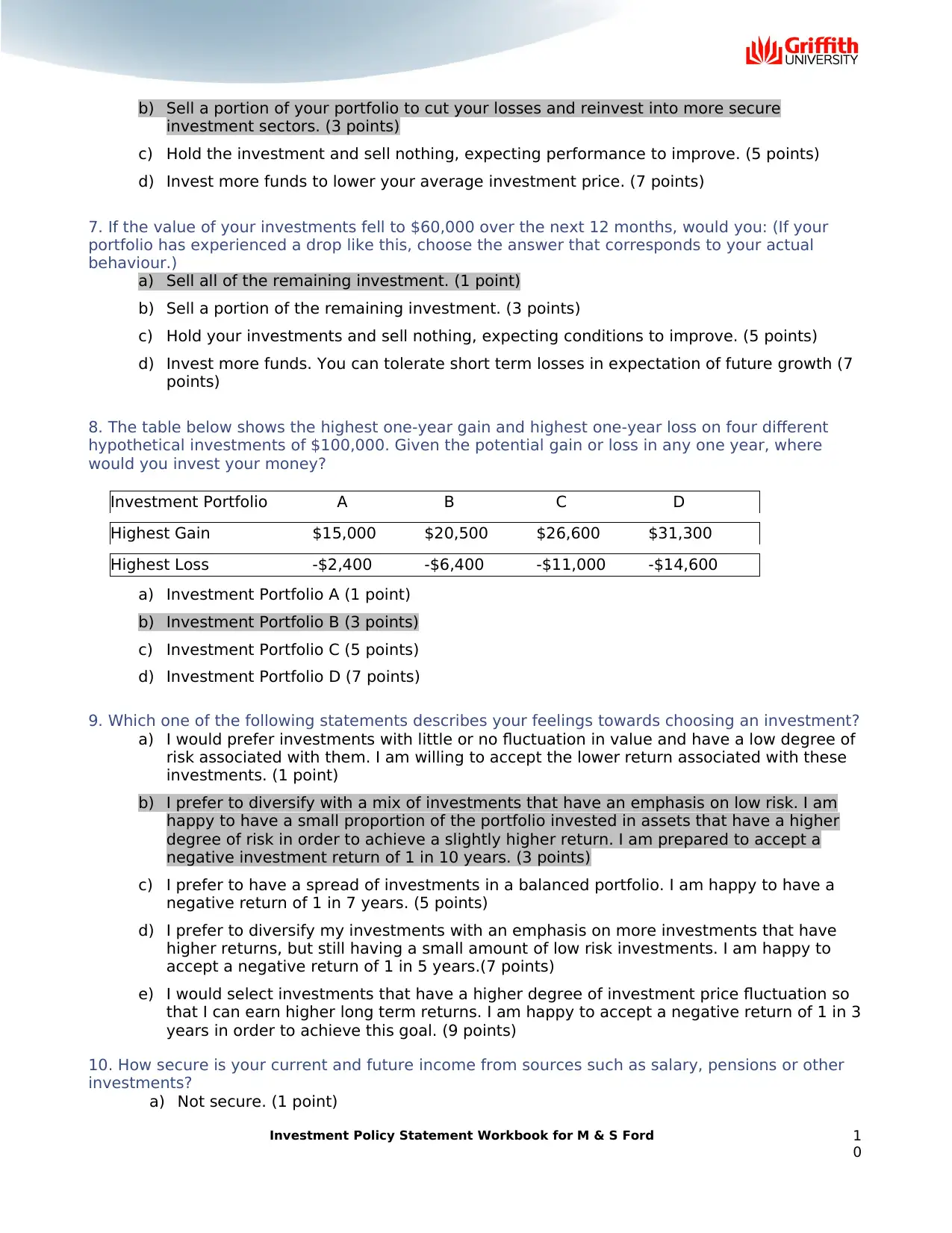
b) Sell a portion of your portfolio to cut your losses and reinvest into more secure
investment sectors. (3 points)
c) Hold the investment and sell nothing, expecting performance to improve. (5 points)
d) Invest more funds to lower your average investment price. (7 points)
7. If the value of your investments fell to $60,000 over the next 12 months, would you: (If your
portfolio has experienced a drop like this, choose the answer that corresponds to your actual
behaviour.)
a) Sell all of the remaining investment. (1 point)
b) Sell a portion of the remaining investment. (3 points)
c) Hold your investments and sell nothing, expecting conditions to improve. (5 points)
d) Invest more funds. You can tolerate short term losses in expectation of future growth (7
points)
8. The table below shows the highest one-year gain and highest one-year loss on four different
hypothetical investments of $100,000. Given the potential gain or loss in any one year, where
would you invest your money?
Investment Portfolio A B C D
Highest Gain $15,000 $20,500 $26,600 $31,300
Highest Loss -$2,400 -$6,400 -$11,000 -$14,600
a) Investment Portfolio A (1 point)
b) Investment Portfolio B (3 points)
c) Investment Portfolio C (5 points)
d) Investment Portfolio D (7 points)
9. Which one of the following statements describes your feelings towards choosing an investment?
a) I would prefer investments with little or no fluctuation in value and have a low degree of
risk associated with them. I am willing to accept the lower return associated with these
investments. (1 point)
b) I prefer to diversify with a mix of investments that have an emphasis on low risk. I am
happy to have a small proportion of the portfolio invested in assets that have a higher
degree of risk in order to achieve a slightly higher return. I am prepared to accept a
negative investment return of 1 in 10 years. (3 points)
c) I prefer to have a spread of investments in a balanced portfolio. I am happy to have a
negative return of 1 in 7 years. (5 points)
d) I prefer to diversify my investments with an emphasis on more investments that have
higher returns, but still having a small amount of low risk investments. I am happy to
accept a negative return of 1 in 5 years.(7 points)
e) I would select investments that have a higher degree of investment price fluctuation so
that I can earn higher long term returns. I am happy to accept a negative return of 1 in 3
years in order to achieve this goal. (9 points)
10. How secure is your current and future income from sources such as salary, pensions or other
investments?
a) Not secure. (1 point)
Investment Policy Statement Workbook for M & S Ford 1
0
investment sectors. (3 points)
c) Hold the investment and sell nothing, expecting performance to improve. (5 points)
d) Invest more funds to lower your average investment price. (7 points)
7. If the value of your investments fell to $60,000 over the next 12 months, would you: (If your
portfolio has experienced a drop like this, choose the answer that corresponds to your actual
behaviour.)
a) Sell all of the remaining investment. (1 point)
b) Sell a portion of the remaining investment. (3 points)
c) Hold your investments and sell nothing, expecting conditions to improve. (5 points)
d) Invest more funds. You can tolerate short term losses in expectation of future growth (7
points)
8. The table below shows the highest one-year gain and highest one-year loss on four different
hypothetical investments of $100,000. Given the potential gain or loss in any one year, where
would you invest your money?
Investment Portfolio A B C D
Highest Gain $15,000 $20,500 $26,600 $31,300
Highest Loss -$2,400 -$6,400 -$11,000 -$14,600
a) Investment Portfolio A (1 point)
b) Investment Portfolio B (3 points)
c) Investment Portfolio C (5 points)
d) Investment Portfolio D (7 points)
9. Which one of the following statements describes your feelings towards choosing an investment?
a) I would prefer investments with little or no fluctuation in value and have a low degree of
risk associated with them. I am willing to accept the lower return associated with these
investments. (1 point)
b) I prefer to diversify with a mix of investments that have an emphasis on low risk. I am
happy to have a small proportion of the portfolio invested in assets that have a higher
degree of risk in order to achieve a slightly higher return. I am prepared to accept a
negative investment return of 1 in 10 years. (3 points)
c) I prefer to have a spread of investments in a balanced portfolio. I am happy to have a
negative return of 1 in 7 years. (5 points)
d) I prefer to diversify my investments with an emphasis on more investments that have
higher returns, but still having a small amount of low risk investments. I am happy to
accept a negative return of 1 in 5 years.(7 points)
e) I would select investments that have a higher degree of investment price fluctuation so
that I can earn higher long term returns. I am happy to accept a negative return of 1 in 3
years in order to achieve this goal. (9 points)
10. How secure is your current and future income from sources such as salary, pensions or other
investments?
a) Not secure. (1 point)
Investment Policy Statement Workbook for M & S Ford 1
0
Paraphrase This Document
Need a fresh take? Get an instant paraphrase of this document with our AI Paraphraser
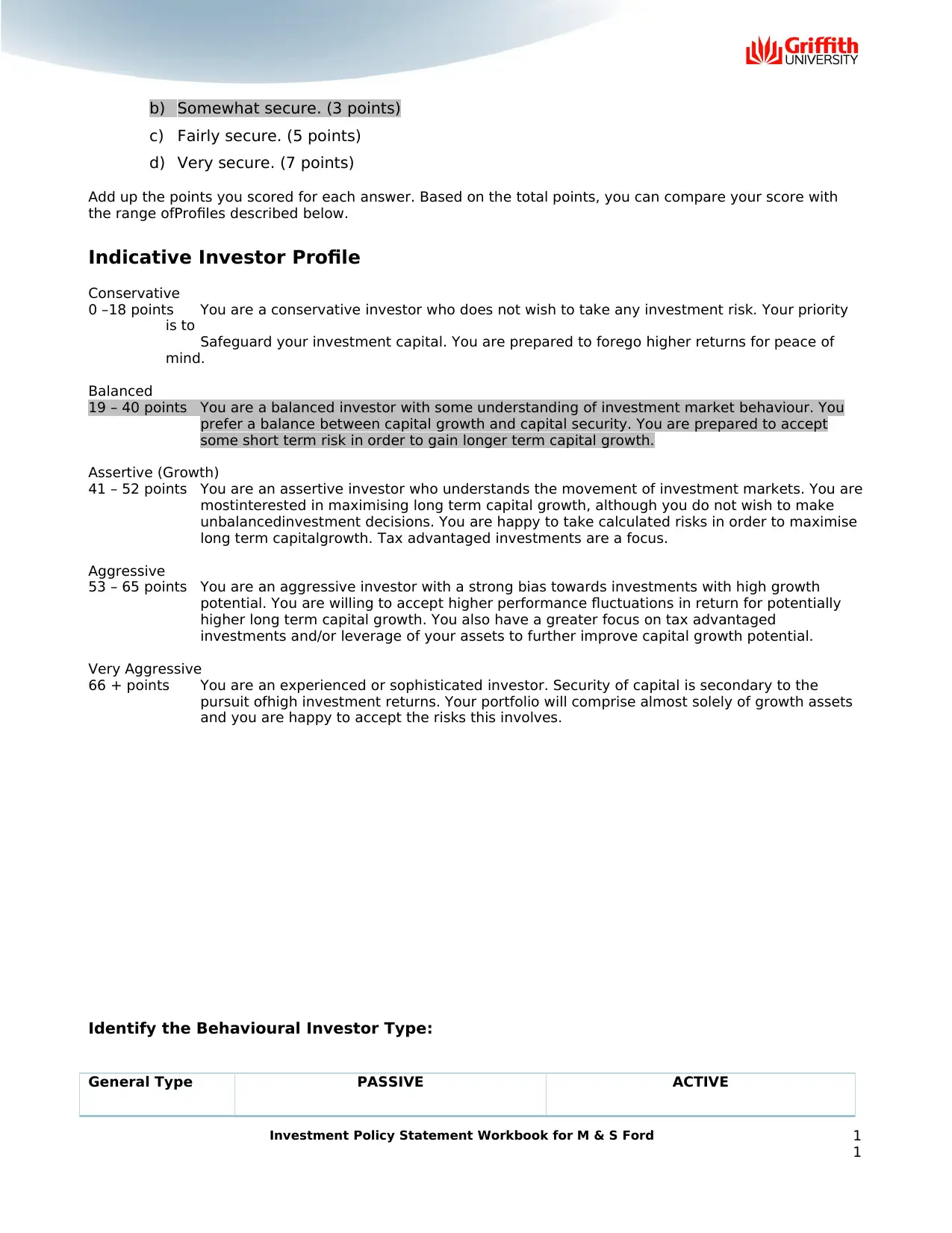
b) Somewhat secure. (3 points)
c) Fairly secure. (5 points)
d) Very secure. (7 points)
Add up the points you scored for each answer. Based on the total points, you can compare your score with
the range ofProfiles described below.26 - AFSL Licence 235410)
Questionnaire
Risk Profile Questionnaire
Indicative Investor Profile
Conservative
0 –18 points You are a conservative investor who does not wish to take any investment risk. Your priority
is to
Safeguard your investment capital. You are prepared to forego higher returns for peace of
mind.
Balanced
19 – 40 points You are a balanced investor with some understanding of investment market behaviour. You
prefer a balance between capital growth and capital security. You are prepared to accept
some short term risk in order to gain longer term capital growth.
Assertive (Growth)
41 – 52 points You are an assertive investor who understands the movement of investment markets. You are
mostinterested in maximising long term capital growth, although you do not wish to make
unbalancedinvestment decisions. You are happy to take calculated risks in order to maximise
long term capitalgrowth. Tax advantaged investments are a focus.
Aggressive
53 – 65 points You are an aggressive investor with a strong bias towards investments with high growth
potential. You are willing to accept higher performance fluctuations in return for potentially
higher long term capital growth. You also have a greater focus on tax advantaged
investments and/or leverage of your assets to further improve capital growth potential.
Very Aggressive
66 + points You are an experienced or sophisticated investor. Security of capital is secondary to the
pursuit ofhigh investment returns. Your portfolio will comprise almost solely of growth assets
and you are happy to accept the risks this involves.
Identify the Behavioural Investor Type:
General Type PASSIVE ACTIVE
Investment Policy Statement Workbook for M & S Ford 1
1
c) Fairly secure. (5 points)
d) Very secure. (7 points)
Add up the points you scored for each answer. Based on the total points, you can compare your score with
the range ofProfiles described below.26 - AFSL Licence 235410)
Questionnaire
Risk Profile Questionnaire
Indicative Investor Profile
Conservative
0 –18 points You are a conservative investor who does not wish to take any investment risk. Your priority
is to
Safeguard your investment capital. You are prepared to forego higher returns for peace of
mind.
Balanced
19 – 40 points You are a balanced investor with some understanding of investment market behaviour. You
prefer a balance between capital growth and capital security. You are prepared to accept
some short term risk in order to gain longer term capital growth.
Assertive (Growth)
41 – 52 points You are an assertive investor who understands the movement of investment markets. You are
mostinterested in maximising long term capital growth, although you do not wish to make
unbalancedinvestment decisions. You are happy to take calculated risks in order to maximise
long term capitalgrowth. Tax advantaged investments are a focus.
Aggressive
53 – 65 points You are an aggressive investor with a strong bias towards investments with high growth
potential. You are willing to accept higher performance fluctuations in return for potentially
higher long term capital growth. You also have a greater focus on tax advantaged
investments and/or leverage of your assets to further improve capital growth potential.
Very Aggressive
66 + points You are an experienced or sophisticated investor. Security of capital is secondary to the
pursuit ofhigh investment returns. Your portfolio will comprise almost solely of growth assets
and you are happy to accept the risks this involves.
Identify the Behavioural Investor Type:
General Type PASSIVE ACTIVE
Investment Policy Statement Workbook for M & S Ford 1
1
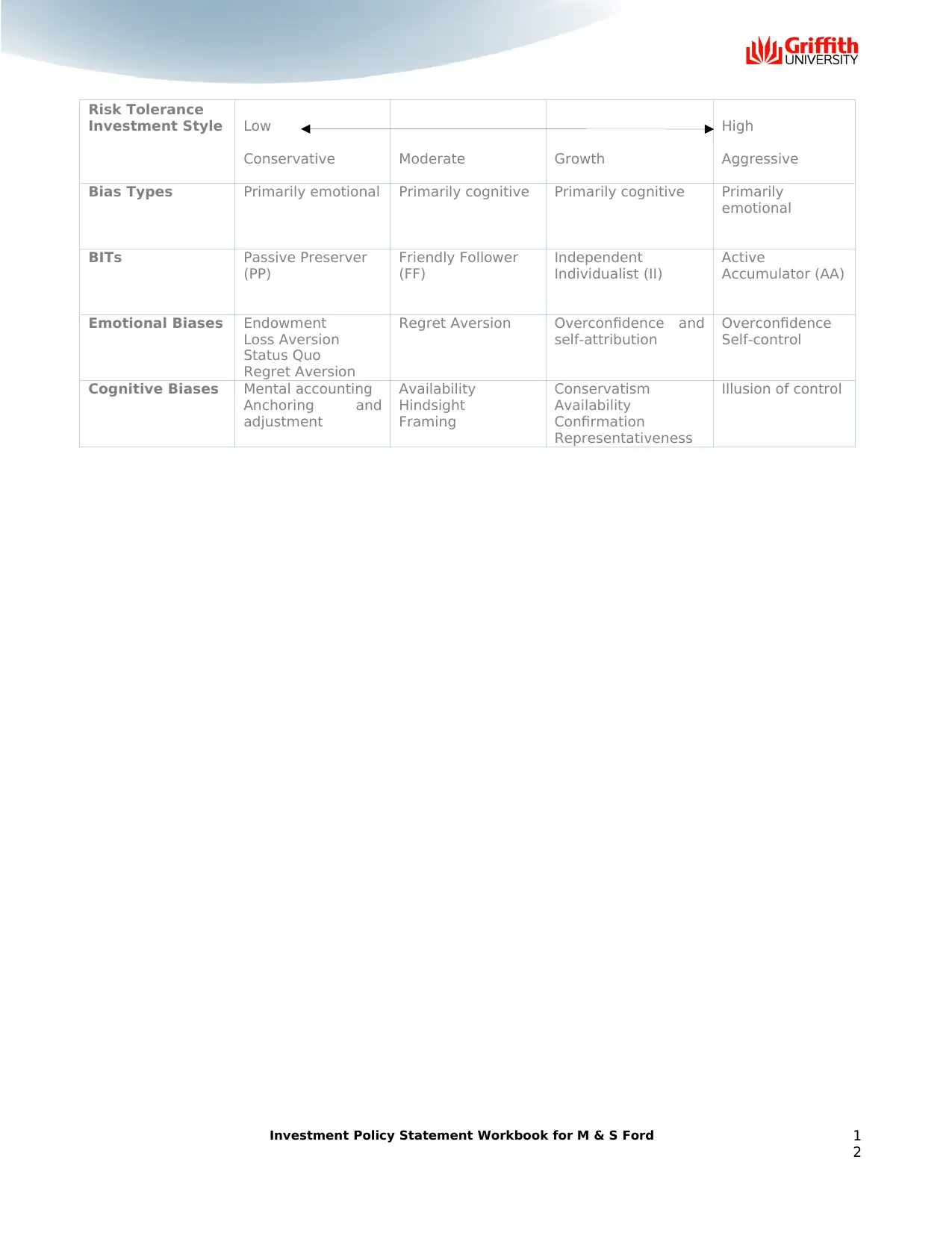
Risk Tolerance
Investment Style Low
Conservative Moderate Growth
High
Aggressive
Bias Types Primarily emotional Primarily cognitive Primarily cognitive Primarily
emotional
BITs Passive Preserver
(PP)
Friendly Follower
(FF)
Independent
Individualist (II)
Active
Accumulator (AA)
Emotional Biases Endowment
Loss Aversion
Status Quo
Regret Aversion
Regret Aversion Overconfidence and
self-attribution
Overconfidence
Self-control
Cognitive Biases Mental accounting
Anchoring and
adjustment
Availability
Hindsight
Framing
Conservatism
Availability
Confirmation
Representativeness
Illusion of control
Investment Policy Statement Workbook for M & S Ford 1
2
Investment Style Low
Conservative Moderate Growth
High
Aggressive
Bias Types Primarily emotional Primarily cognitive Primarily cognitive Primarily
emotional
BITs Passive Preserver
(PP)
Friendly Follower
(FF)
Independent
Individualist (II)
Active
Accumulator (AA)
Emotional Biases Endowment
Loss Aversion
Status Quo
Regret Aversion
Regret Aversion Overconfidence and
self-attribution
Overconfidence
Self-control
Cognitive Biases Mental accounting
Anchoring and
adjustment
Availability
Hindsight
Framing
Conservatism
Availability
Confirmation
Representativeness
Illusion of control
Investment Policy Statement Workbook for M & S Ford 1
2
⊘ This is a preview!⊘
Do you want full access?
Subscribe today to unlock all pages.

Trusted by 1+ million students worldwide
1 out of 16
Related Documents
Your All-in-One AI-Powered Toolkit for Academic Success.
+13062052269
info@desklib.com
Available 24*7 on WhatsApp / Email
![[object Object]](/_next/static/media/star-bottom.7253800d.svg)
Unlock your academic potential
Copyright © 2020–2025 A2Z Services. All Rights Reserved. Developed and managed by ZUCOL.





![Managerial Accounting Assignment Solution - [University] [Semester]](/_next/image/?url=https%3A%2F%2Fdesklib.com%2Fmedia%2Fimages%2Fnr%2Feb6ffb76356e457ab3cc2da237f03df4.jpg&w=256&q=75)